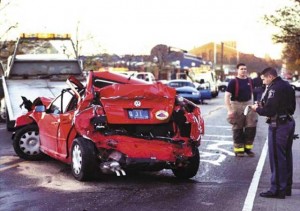If you’ve driven a car, truck or SUV, you’ve most likely engaged in it. It can come out of the blue or just be the climax of a rough day at work followed by an even rougher commute home: road rage.
A new study shows that about 80% of U.S. drivers exhibited some form of “anger, aggression or road rage” at least once in the last year. These actions can range from a simple glare for a motorist driving too slowly in the fast lane or showing someone you think they are “No. 1” even though they drive like “No. 2” after being cut off.
While those are common, and some might argue fairly harmless reactions, AAA says that increasingly responses are becoming more aggressive. The most alarming findings suggest that approximately 8 million U.S. drivers engaged in extreme examples of road rage, including purposefully ramming another vehicle or getting out of the car to confront another driver.
“Inconsiderate driving, bad traffic and the daily stresses of life can transform minor frustrations into dangerous road rage,” said Jurek Grabowski, director of Research for the AAA Foundation for Traffic Safety. “Far too many drivers are losing themselves in the heat of the moment and lashing out in ways that could turn deadly.”
(Gas prices expected to continue to falling. For more, Click Here.)

Most forms of road rage are involve simple gestures; however, a rising number of incidents involve ramming or deliberately hitting another vehicle.
According to the study’s estimates, here are some of the most common forms of road rage from last year:
- Purposefully tailgating: 51% (104 million drivers)
- Yelling at another driver: 47% (95 million drivers)
- Honking to show annoyance or anger: 45% (91 million drivers)
- Making angry gestures: 33% (67 million drivers)
- Trying to block another vehicle from changing lanes: 24% (49 million drivers)
- Cutting off another vehicle on purpose: 12% (24 million drivers)
- Getting out of the vehicle to confront another driver: 4% (7.6 million drivers)
- Bumping or ramming another vehicle on purpose: 3% (5.7 million drivers)
Additionally, the problem is not improving. More than 60% of drivers surveyed believe that aggressive driving is a bigger problem today than three years ago, and 90% feel aggressive drivers are a serious threat to their personal safety.
Not surprisingly, the type of road rage and behaviors associated with it varies with age, gender and geographic region. For example, male drivers aged 19-39 were more likely to engage in aggressive behaviors like getting out of a vehicle to confront another driver or ram another vehicle.
(Click Here for details about GM’s new legal setback.)
Drivers in the northeastern U.S. are more likely to yell, honk or make gestures at other drivers than other parts of the country. Somewhat ironically, drivers who reported other unsafe behaviors behind the wheel, such as speeding and running red lights, also were more likely to show aggression. For example, drivers who reported speeding on a freeway in the past month were four times more likely to have cut off another vehicle on purpose.
AAA offers these tips to help prevent road rage:
- Don’t Offend: Never cause another driver to change their speed or direction. That means not forcing another driver to use their brakes, or turn the steering wheel in response to something you have done.
- Be Tolerant and Forgiving: The other driver may just be having a really bad day. Assume that it’s not personal.
- Do Not Respond: Avoid eye contact, don’t make gestures, maintain space around your vehicle and contact 9-1-1 if needed.
(To see more about California regulators rejecting VW’s plan to repair 3.0-liter diesels, Click Here.)
“It’s completely normal for drivers to experience anger behind the wheel, but we must not let our emotions lead to destructive choices,” said Jake Nelson, AAA’s director of Traffic Safety Advocacy and Research. “Don’t risk escalating a frustrating situation because you never know what the other driver might do. Maintain a cool head, and focus on reaching your destination safely.”

